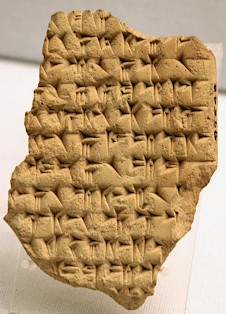Persian Alphabet
Persian Alphabet: script of thirty-six signs and eight ideograms, used in the Achaemenid Royal Inscriptions.

When the Persian king Darius I the Great (r.522-486) ordered the Behistun inscription to be made, he also ordered the creation of a special, Persian alphabet, which he called "the Aryan script". It consists of thirty-six signs indicating syllables and eight ideograms for the words "king", "country" (2x) "good", "god", "earth", and "Ahuramazda" (3x). A slanting wedge (\) is used as a word divider.
This alphabet was mainly used for the set of royal texts that is known as the "Achaemenid Royal Inscriptions". The last text in this "Aryan script" can be dated to the fourth century BCE.
Decipherment
The Persian cuneiform script was deciphered by Henry Rawlinson in the summer of 1835. He had already recognized the word Dârayavauš (Darius) in Persepolis and recognized the same letters when he started to study the Behistun Inscription. When he received some notes by the German scholar Georg Friedrich Grotefend, who had also studied the hitherto incomprehensible signs, Rawlinson was able to break the code. The first lines of the inscription contained a list of personal names that was almost identical to a similar list in the Histories of the Greek researcher Herodotus.note This confirmed Rawlinson's readings and within two weeks, he was able to establish the meaning of all signs of the old Persian alphabet.
Since Rawlinson knew the Persian language and had read the age-old sacred book Avesta, he was soon able to read the entire text and to understand grammar, syntax, and vocabulary of ancient Persian. In 1838 he handed over his first results to the Royal Asiatic Society in London and the Société Asiatique in Paris. Eight years later, he started to publish on the "Persian Cuneiform Inscription at Behistun, Deciphered and Translated" in the Journal of the Royal Asiatic Society.
The Behistun Inscription is written in three cuneiform scripts - Persian, Babylonian, and Elamite - and Rawlinson, understanding the first of these three scripts, started the decipherment of the second, which consists of some 500 characters. He succeeded in 1852; from now one, scholars were able to read the flood of clay tablets coming from the excavations at Nineveh.
In the early twentieth century, Niels Westergaard and Edwin Norris managed to decipher the 131 characters of the Elamite script and were able to read the old language: an impressive achievement since Elamite is a dead language, related to no known spoken tongue.